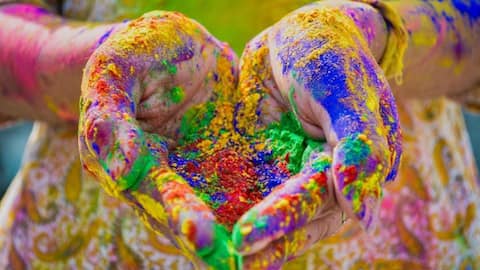Exploring Holi celebrations across India
What's the story
In India's rich cultural landscape, Holi emerges as a dazzling celebration, weaving together diverse traditions and heritage. As spring blossoms, people from diverse backgrounds converge to revel in the festive spirit, fostering laughter and harmony. From the snowy peaks of the Himalayas to the sunlit plains of the Deccan, there are diverse Holi celebrations across Indian states.
Braj ki Holi
Uttar Pradesh
The 10-day Braj Ki Holi celebrations in Uttar Pradesh, preceding the main Holi festivities, are distinguished by their unique, creative, and lively rituals. Inspired by the lives of Lord Krishna and Radha, these traditions originate from the towns of Mathura, Vrindavan, Barsana, Nandgaon, and Gokul. Dedicated to the lord, who spent his childhood in these regions, these celebrations honor the vibrant spirit of Holi.
Hola Mohalla
Punjab
In Punjab, Holi is celebrated as Hola Mohalla, featuring martial arts displays, processions, and cultural performances. Traditionally, Sikhs observed the festival known as Hola until the 19th century. Later, Guru Gobind Singh expanded Holi into a three-day event called Hola Mohalla, emphasizing martial arts. The extension, starting after Holi, involved Sikh soldiers engaging in mock battles, horsemanship, athletics, archery, and military exercises.
Dol Jatra
West Bengal
Dol Jatra and Dol Purnima in West Bengal mark the Holi celebrations. The highlight is Basant Utsav, the Spring Festival. Elaborately adorned palanquins carry Krishna and Radha's idols through the city's streets, observed with grace. Devotees swing idols as women sing and dance around the swing. Men add to the jubilant atmosphere by playfully spraying colored water and powder, known as abeer.
Dhuleti
Gujarat
In Gujarat, India, the festival is known as Dhuleti. People engage in a lively procession with traditional music and dance, exchanging colored powders. Effigies of the demon Holika are burnt, where there are large community gatherings and the burning of bonfires to mark the victory of good over evil. This is followed by feasting on traditional sweets and savory dishes.
Rang Panchami
Maharashtra
In Maharashtra, Holi transforms into Rang Panchami, observed five days after the main festival. Revelers engage in vibrant color play, accompanied by rhythmic dhols and traditional feasting on sweets and savory delights. Some regions also embrace a distinctive street tradition of communal singing and musical performances. A coconut or Puran Poli is ceremonially cast into the bonfire as a sacred offering.
Shigmo
Goa
In Goa, the spring festival known as Shigmo unfolds as a grand carnival featuring traditional folk songs, street dances, and vibrant color play. Alongside, fishermen's boats, adorned with religious and mythological motifs, add to the coastal charm. Shigmo is celebrated in two customs: Dhakto Shigmo, observed by rural communities, farmers, and laborers, and Vhadlo Shigmo, celebrated by the broader populace.
Khadi Holi
Uttarakhand
Kumaoni Holi, celebrated in Uttarakhand's Kumaon region, unfolds across several towns over a couple of months. Unlike other states, it's more of a musical event than a colorful one, marking the beginning of the sowing season. The celebration manifests in Baithaki Holi and Khadi Holi, where men clad in traditional attire dance to Holi tunes, and Mahila Holi, an exclusive event for women.
